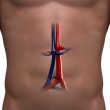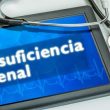The use of endovascular aneurysm repair (EVAR) for the treatment of infrarenal abdominal aortic aneurysms is widely spread, due to its minimally invasive approach, rapid recovery, and better short-term survival. Approximately 60% of all infrarenal abdominal aortic aneurysms (AAAs) repairs in Europe and 85% in the United States are by EVAR. A decade ago, we believed...
Cost-Effectiveness of Frenestrated or Branched Endoprostheses vs. Open Surgery
Fenestrated of branched endoprostheses are appealing options for the repair of anatomically-complex aortic aneurysms. Their use is limited by their cost (which is high for everyone, everywhere) and also by the lack of a head-to-head study showing best results than open surgery. This work offers results at 2 years for these devices, including an economic assessment...
Surprisingly, some patients won’t do as told and have less events
Today endovascular aneurysm repair (EVAR) is the preferred option to treat patients with abdominal aortic aneurysms, even though studies have shown reintervention rate is around 20% at 5 years. Consequently, guidelines recommend life EVAR surveillance imaging to identify and treat eventual leaks and prevent aneurysms from growing and eventually rupturing. There are several population and observational studies...
On Radiation Protection: Editorial comment by Dr. Ariel Durán
Courtesy of Dr. Ariel Durán. I am pleased to witness the increased amount of scientific papers in high impact journals addressing topics related to radiation protection or the harmful effects of radiation on our patients and primary or secondary operators. Similarly, it is my pleasure to see that SOLACI has acknowledged this growing concern by...
Persistent intraoperative leak Type 1A after stent implantation
Original title: Outcomes of persistent intraoperativa Type Ia endoleak after Standard endovascular aneurysm repair. Reference: Alistair Millen, et al. J. Vasc. Surg 2015;61:1185-91 The purpose of Endovascular Aneurysm Repair (EVAR) in the infrarenal abdominal aortic aneurysms (IAAA) is to prevent growth and rupture. Inadequate proximal seal by the stent favors the presence of leak type 1A that preserves...
How Is Renal Function Affected by Endoprosthesis Implantation?
The occurrence of renal failure after any endovascular intervention is associated with increased morbility and mortality. After a coronary intervention (whether it be angioplasty or surgery), renal failure increases mortality 20-fold. Relatedly, surgical repair of an abdominal aortic aneurysm with renal failure is also associated with a significant increase in the number of events. Read...
Endoleaks Type II: no association with mortality
Original Title: Risk factors and consequences of persistent type II endoleaks. Reference: Ruby C. Lo et al. J Vasc Surg 2016;63:895-901 The presence of type II endoleaks is infrequent (1%-10%) and most cases resolve spontaneously at 12 months. When they don’t, there is still controversy as to whether they may be associated to aneurysm diameter...






